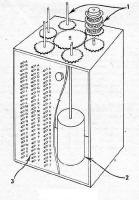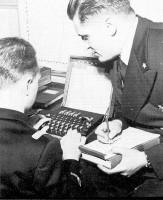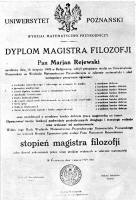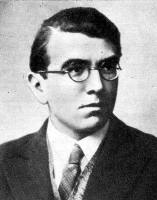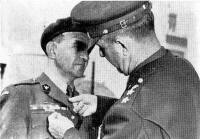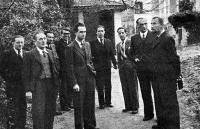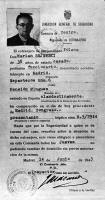
By Jan Bury
E-Mail: yahya(at)orient.uw.edu.pl
Contents
1. Foreword
2. Polish Pre-War
Code Breakers in the Early Period (1930s)
3. The Methods of Cipher Breach
4. Beginning of the W.W.II -
Evacuation to France
5. Conclusions
6. Sources
1. Foreword
There have been numerous articles and books about the Enigma code breach. However, the
role that the Polish cryptologists' school had played in it has always been omitted. Such
an approach was spread since 1974, when F. W. Winterbotham published a book titled
"The Ultra Secret," where he claimed that the British were the first to break
this cipher. It is very little known in the West, that the first to break the
Enigma-enciphered messages were the Poles and this happened in the 1930s.
There in also an absurd version spread by Mr. Winterbotham, who claims that the British got an Enigma from Poles, who apparently had stolen a set from a German factory, thanks to their mythical agent who was employed there.
My intention was to make a reliable approach for a reader in the West concerning the greatest mystery of World War II. I decided to base on the published sources that are available in Poland and are considered as official and reliable.
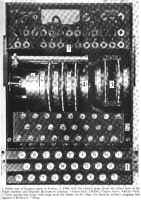 Polish 3 Rotor Enigma Machine |
2.
Polish Pre-War Code Breakers In The Early Period (1930s) The first trials in Poland to break the newly introduced cipher by the Wehrmacht and Kriegsmarine were in 1928. The messages that were encoded with a new cipher were being picked up by four Polish ELINT stations: in Warsaw, Starogard near Gdansk (or then Danzig), in Poznan and in Krzeslawice near Cracow. Unfortunately, the methods involved in breaking the cipher code were fruitless. It seemed that the new cipher was a strong cryptography and cannot be cracked in an easy way. Therefore, the Ciphers Office (BS) of the Polish Army's General Staff decided to ask mathematicians for help. In January 1929, the Dean of the Department of Mathematics, Professor Zdzislaw Krygowski from the University of Poznan, made a list of his best graduating students who could have started working at the Ciphers Office. Later these students graduated a course of cryptography prepared by the Office. The best were: Marian Rejewski, Jerzy Rozycki and Henryk Zygalski who could work both at the University and at the General Staff's Ciphers Office without any problems at that time. In the autumn of 1930, a new branch of the Ciphers Office was opened in utmost secrecy in Poznan. Rejewski, as well as his colleagues were employed there. In 1932, the group was moved to Warsaw, to start working on the Enigma Cipher. Their first success was a German Navy 4-letter cipher break. Rejewski was considered a leading cryptologist within the group. He was looking forward the new way of breaking the sophisticated German code. Since the Polish intelligence got an Enigma machine, Rejewski could develop the scheme of encryption from the mathematical point of view. Unfortunately, that machine was a commercial product, and the German army used the more complicated Enigma with auxiliary connectors' plate at the front panel. During 1931, Polish Intelligence co-operated with the French Deuxieme Bureau, which led a most important agent within the Reichswehr Cipher's Office. Rejewski got a description of the militarised Enigma, as well as old keys tables. This helped him to eliminate many unknown figures in the permutation-alike equation he had previously created. Finally, in December 1932, Rejewski reconstructed the Enigma's internal connections. In January, 1933, the two other cryptologist became also involved in Rejewski's work. In the same month, the first German messages were decrypted. Since then, the General Staff had access to the most secret data transmitted by the German Army, Navy, Air Force, as well as the Ministry of Foreign Affairs. It is being estimated, that during the 6-year period of Polish reading of the Enigma messages (between January, 1933 and September, 1939), about 100.000 transmissions were deciphered. The most important concerned the remilitarization of the Rhine Province, Anschluss of Austria and seizure of the Sudetenland, the last could be dangerous to Poland's interests. The fact that the Enigma cipher was cracked was kept in the utmost secrecy even within the Polish General Staff's II Directorate. The officers got the messages signed with a code-name "Wicher" (that was the Enigma code break) that were considered fully reliable, but the source was classified. In 1934, the General Staff's Cipher Office established a new site for their German branch (BS-4) in the Kabaty Forest near Warsaw. Rejewski and his colleagues have been working there until the breakout of WW II on 1 September, 1939. Although the French helped the Poles with the Enigma code break, the fact was in exclusive hands of Poles until July 1939. 3. The Methods Of Cipher Breach On 15 September, 1938, just two weeks before the conference in Munich, the Germans changed drastically their methods of using the Enigma cipher. Since the new key scheme seemed to be more complicated, the Polish cryptologists invented the first mechanical pseudo-computers to help them in their work. In October 1938, Rejewski designed a machine named "bomba kryptologiczna" (a cryptologic bomb), which was soon produced at the AVA Workshops. Also a "cyclometer" machine helped to assess the pattern of the key. Simultaneously, the new method of a double-key crack was invented, which consisted of using sheets of paper with 51 by 51 holes (each set consisted of 26 sheets). The method allowed finding convergent places for the entire set. However, starting with December 1938, the Germans upgraded their Enigma machines with 2 extra ciphering rotors (altogether 5 rotors). Although the Polish cryptographers could still read the German messages, the mass decryption effort required using 60 instead of only six cryptologic bombs and 60 paper sheets sets. During mid-July, 1939, Chief-of-Staff Lt.-Gen. Waclaw Stachiewicz, authorised the Ciphers Office to share all their knowledge on Enigma with the allied intelligence services. The representatives of France and England got Polish-made clones of the Enigma encryption machine during the meeting in Warsaw between 24 and 26 July, 1939. On 16 August 1939, General Stewart Menzies was given a copy of Enigma at the Victoria Station in London. The British begun to read the Enigma messages in mid-August, 1939. 4. Beginning Of The
W.W.II - Evacuation To France In October 1939, a joint Polish-French radio intelligence centre in Gretz-Armainvillers near Paris was created. It was given a code name "Bruno." Furthermore, the "Bruno" centre had a Teletype link to Gov't Code and Ciphers School in England. There were also Spanish code breakers employed at "Bruno" to crack the Spanish and Italian ciphers. |
 3 Rotor Enigma Machine |
|
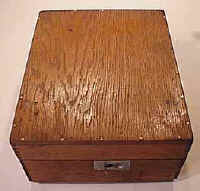 Enigma Machine, Closed |
|
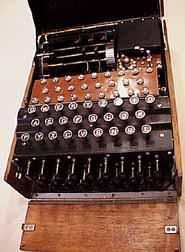 Enigma Machine |
|
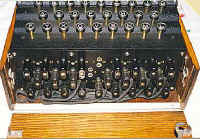 Enigma Machine Plug Panel |
|
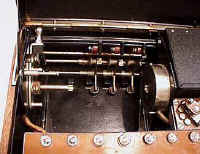 Enigma Machine Rotors |
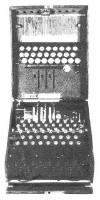 Military Grade Enigma |
|
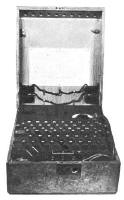 Military Grade Enigma |
|
 Military Grade Enigma |
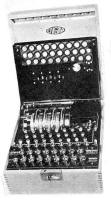 Civil-Use Enigma |
|
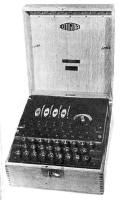 Civil-Use Enigma |
|
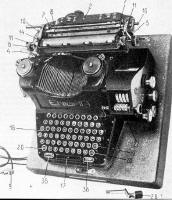 An Early Enigma Model B |
The main problem the cryptologists were facing was the exchange of the key system, which took place in the German Army on 1 July, 1939. The first decrypted message at the "Bruno" centre on 17 January 1940 was from 28 October 1939.
The most helpful messages to assess the routine of the German Army Signals Corps were those sent every day just before 2400 hours. There was important information on call signs, wavelengths, and hours of operation, etc.
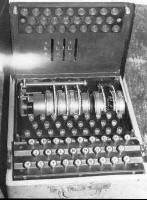 Pre-war French Enigma clone made thanks to the Polish Intelligence |
|
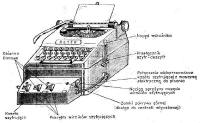 Lacida A Polish-made crypto machine used in diplo communications. Photo from 'Szyfr Enigmy - Metody Zlamania' book |
|
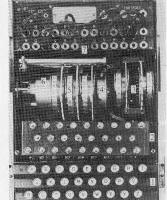 An Enigma Machine |
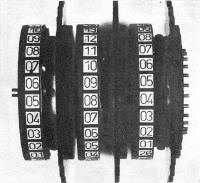 Enigmas Ciphering Rotors |
|
 Enigmas Ciphering Rotors |
|
 Cyclometer machine Drawing from M.Rejewskis papers |
The Polish cryptologists were however to come back soon to occupied France under a secret agreement between the Polish and Free French governments and continue their work in underground in the City of Fouzes near Nimes. In the beginning of October 1940, the new secret unit was formed in Fouzes and code-named "Cadix." The "Bruno" centre successor decrypted the following types of German messages:
- German military orders to the units in Europe and in Libya,
- SS and Police (Polizei) messages from Europe,
- Spy radio communications between the field agents in Europe or in Libya and Abwehr HQ in
Stuttgart,
- Diplomatic communications and German Armistice Commission's
- Communications in Wiesbaden and their branches in France and in North Africa.
Furthermore, the Fouzes "Cadix" unit got a branch in Algiers, led by a Polish II Directorate's officer, Maj. (later Maj.-Gen.) M. Z. Rygor-Slowikowski. The unit was located in the Kouba villa in Algiers' Kouba suburbs. Most of the intelligence gathered by his unit were used in preparation of the "Torch" allied operation (North Africa Landing). Note that the "Kouba" (a.k.a. PO-1 branch) unit encrypted their messages using a Polish-made LCD (a.k.a. "Lacida") enciphering machine, which consisted of a modified Remington typewriter combined with enciphering rotors.
Unfortunately, on 9 January 1942, Jerzy Rozycki died when M/S "Lamoriciere" he was travelling by, sunk near Balearic Isles.
Because of German ELINT threat, the unit's members were evacuated on 6 November 1942. Rejewski and Zygalski managed to get to neutral Spain. Later, via Gibraltar, they were transferred to England, where they started working at the Polish Army Signals Corps in Boxmoor near London, in fact for the Polish Armed Forces Branch "300" of the II Directorate. They later cracked the German SS formations cipher.
5. Conclusions
The ability to read the enemy's communications by the allied forces was very important
factor, which undoubtedly has contributed to the victory over the Nazi Germany. It was the
most important source on the Nazi Germany that the West had. Perhaps, the Soviets were
also given intelligence gathered in such a way.
Unfortunately, there is no evidence that the Poles made any worth use of the intelligence they gathered from Enigma coded messages before 1939. Furthermore, the fact that they possessed such a ability was known by the British. There is also an interesting event, that the Enigma cipher's algorithm was considered strong, and was used in the Unix OS encryption in the 1970s.
6. Sources
1. Krzysztof Gaj: Szyfr Enigmy. Metody Zlamania [Enigma Cipher. The methods of Breaking],
WKL, Warsaw 1989.
2. Wladyslaw Kozaczuk: W kregu Enigmy [In the Enigma Circle], KiW, Warsaw 1986.
3. Andrzej Peplonski: Wywiad Polskich Sil Zbrojnych na Zachodzie 1939-1945.
[Polish Armed Forces, Intelligence in the West 1939-1945], AWM, Warsaw 1995.
4. Marian Rejewski: 'An Application of the Theory of Permutations in Breaking the
Enigma Cipher'
in: Applicaciones Mathematicae. 16, No. 4, Warsaw 1980.
5. Marian Rejewski: 'How Polish Mathematicians Deciphered the Enigma'; in: Annals of the History of Computing. Arlington, Vol. 3, No. 3, July 1981.
Visitors to this page since 27 March 2000 Last updated 02 January 2003
Back to Your Articles Index Page.
Army Radio Sales Co. Home Page.
